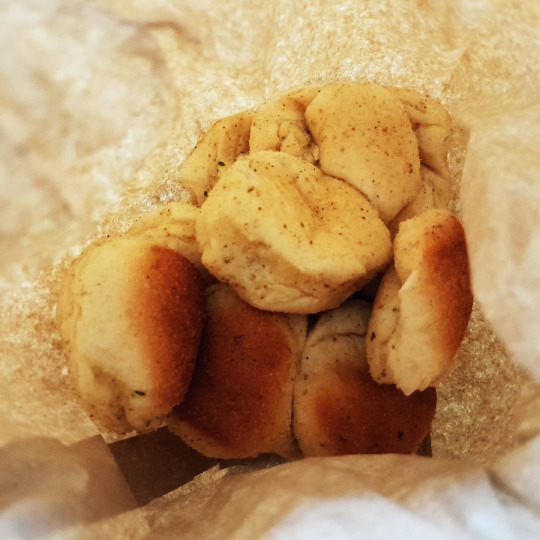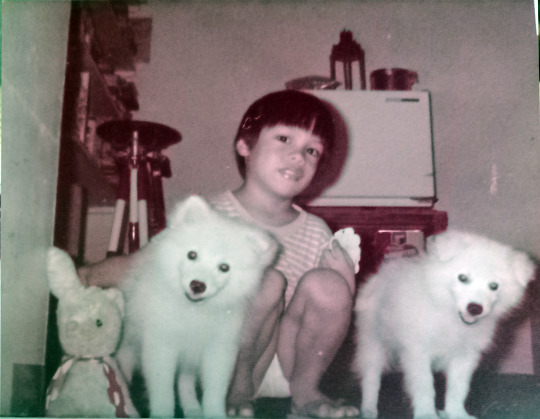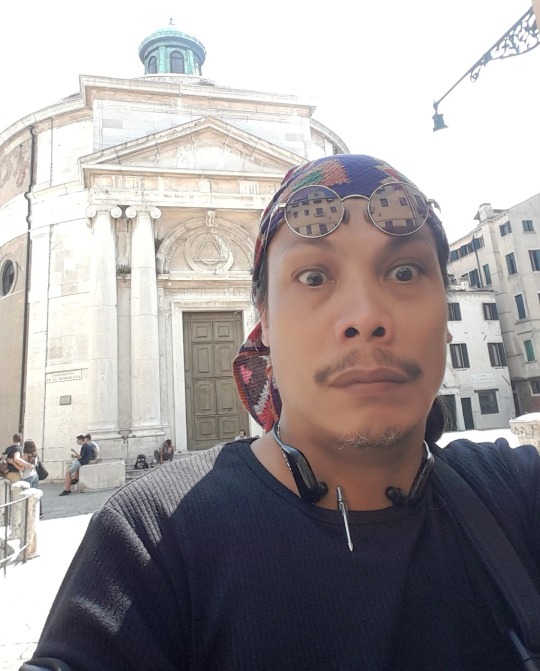Text

Mandala of the Chronos’ Dream Machine: Meditations on Regression
2012
Metallic Gel Pen on Illustration Board
In the swirling
Of Time’s passage
To the past
I was
In the present
I am
To the future
I will be
In the face of the I AM
There is none
1. Acknowledge
Return to what was
And remember all
From man to child
Child to infant
Infant to womb
Womb to void
GOD
2. Release
Move in the infinite
Spin to all possibilities
Of creation
And look back . . .
What is past
Forges the present
And foretells the future
To learn and forgive
To love and not forget
The struggle on the path
Renewed . . .
Reborn . . .
3. Awaken
I am
Is not who I was
I am
Is not who I will be
I am
Here and now
And choose
The light of eternity . . .
4. Return
Still the hands move
Telling day and night
A day to be made
By my will
In ONE
0 notes
Text

The Simple Joys
January 2024
Barangay Sambag, Cebú City
0 notes
Text

Space rocket goupfie
My cousins and I celebrating my birthday at the Fiesta Carnival, in the Cubao District of Quezón City.
The Fiesta Carnival was developed by the family of the industrialist José Amado Araneta (1907-1985) in 1971; to become the Philippines’ first indoor entertainment center with carnival rides, games, eateries, and even slot machines. Araneta envisioned the Cubao District as a commercial hub of the Metro Manila region, which most of the City of Manila was still in the middle of reconstruction from the devastation wrought by World War II (1941-1945) in the Philippines.
From my childhood to early adulthood, the Fiesta Carnival was an important part of my family’s life; even when we moved from Cubao to Marikina City. It did start with my parents taking me and my siblings to entertain us on special occasions, then it soon evolved to a place for my teenage barkada (close friends’ group) to hang around, and finally it became the venue I would regularly take my nephews for a day of fun.
Sadly the Fiesta Carnival had already closed down when my daughter was born, so I was unable to continue the tradition with her. And now that the Fiesta Carnival has reopened in 2023, I no longer live in Quezón City to take a visit with my family.
For more information of Cubao, I wrote the article: “Growing Up in Cubao, Quezon City: History and Art” (https://lakansining.wordpress.com/2019/01/07/growing-up-in-cubao-quezon-city-history-and-art/)
This photo was taken circa 1980
0 notes
Text

Sol Invictus: The Unconquered Sun
2013
Metallic Gel Pen on Illustration Board
0 notes
Text

The Road from Babylon to Jerusalem
January 2024
Barangay Santo Niño, Cebú City
0 notes
Text

Spitz triplefie
Posing with our pet Japanese Spitz (日本スピッツ, Nihon Supittsu) Fluffy and Snow, in our home along Sanggumay Street, in Barangay Plain View, Mandaluyong City.
The domestic dog (Canis lupus familiaris) Nihon Supittsu breed was developed in Japan between the 1920s and 1930s, and has recently regained popularity for their “cuteness”.
My family had a liking for fluffy dog breeds, which may have been influenced by my maternal gradfather who had a Chow-chow (鬆獅犬, sōng shī quǎn). We would later get our own chow-chow in the 1980s.
This photograph was taken circa 1974
0 notes
Text

The Sacred Path: Mandala of the Oracle of Love
2012
Metallic Gel Pen on Illustration Board
To see what is not there
To hear what is not spoken
To know what has yet to be
Peace
1. Acknowledge
The past, present and future
What was
What is
What will be
What could be
What will never be
The body, mind and heart
What is sensed
What is though
What is felt
Secrets to know
Knowledge to share
To heal . . . The spirit
Of beast, man and planet
Peace
2. Release
The fires burn away illusion
The waters wash away fears
The winds sweeps the self to heights of knowing
And the earth protects me from harm
Call the Scribe of Time
To inscribe the truth forever
Call the Fire Gatherer
To call the people to hear the word
Call the Bridge of Hearts
To embolden the union of fire
Call the Gate Keeper
To reveal the secrets of vision
Call the Minstrel of Light
To intones the lore to their hearts
Peace
3. Awaken
There are no more visions
There are no more dreams
I awaken in union of being and never
And all is known
Peace
4. Return
To all
There is the word . . .
Peace
0 notes
Text

The Queen's Court
January 2024
Barangay Sambag, Cebú City
0 notes
Text

Venezia masonic temple selfie
Magdalena ikaw ay sawimpalad
Kailan ka nila maiintindihan. . .
"Magdalena" by Freddie Aguilar (1983)
Got a bit shocked to see the masonic symbols on the 1790 Chiesa della Santa Maria Maddalena (Church of Saint Mary Magdalene), in Venice, Italy.
Around 1222, there had already been a religious edifice in the site, and was later dedicated to Saint Mary Magdalene by the 14th century. During this period, Mary Magdalene was considered and important saint in the church, with several parishes and convents dedicated to her. Mary Magdalene was the patron saint of women.
The new church was designed by Arch. Tommaso Temanza (1705-1789) who was inspired by the Pantheon in Rome, but he was unable to complete it and he was buried within his masterpiece. The architect to finish the project was Giannantonio Selva (1751-1819).
During French rule of Venice, the church lost its status as a parish church 1810, and subsequently closed in 1820. When the building was reopened a few years later, it only served as a chapel. And in 1888, the bell tower was torn down due to its unstable foundation.
What is most striking of the Santa Maddalena is the masonic “the eye within the triangle” over the tympanum, with the inscription of “Sapienta aedificavit sibi domun” (Wisdom built this House Herself) right below it. Some historians surmise that these symbols were placed by the chiesa’s sponsors, the prominent Balbo clan, who has strong tied to the ancient order of the Knights Templar.
However, it is also noted that Arch. Temanza was most likely influenced by his friend Andrea Memmo (1729-1793) who was the first most well-known Freemason in Venice.
Inside the Chiesa della Santa Maria Maddalenahas a collection of paintings by the Venetian master Giandomenico Tiepolo (1727-1804).
This picture was taken circa 2015
#travel#churchhistory#architecturehistory#filipinotraveler#churcharchitecture#venice#italy#venicechurch#santamariamaddalena#santamariamaddalenavenice
0 notes
Text

Momento Mori
2013
Metallic Gel Pen on Illustration Board
0 notes
Text

The Quartermaster
January 2024
Barangay Santo Niño, Cebú City
0 notes
Text

Ancestral home artwork familyfie
My clan posing inside our paternal ancestral home, in Barangay Sacred Heart, Quezón City. I restored the pre-World War II house and moved my family in 2004.
At the left side and behind my parents is my 1994 painting “Ang Diwa ng Kundiman”. And on the wall behind us is my collection of traditional Filipino hats, collectively called salakot.
For more information on the ancestral home, I wrote the article “Quezon City: The Olivares Story and a Farewell to the Bahay-na-Dilaw” (https://lakansining.wordpress.com/2020/03/15/quezon-city-the-olivares-story-and-a-farewell-to-the-bahay-na-dilaw/)
This photo was taken circa 2007, when we hosted a clan lunch in our home with my parents, siblings, and nephews.
#filipinoart#philippines#cubao#quezoncity#ancestralhouse#ancestralhome#philippineart#philippinepainting
0 notes
Text

The Sacred Path: Mandala of the Scribe of Time
2012
Metallic Gel Pen on Illustration Board
In the beginning there was the WORD
And the word became flesh . . .
Peace
1. Acknowledge
The knowledge of ages
To be sought
To be seen
To be written
To be shared
In a book . . .
In a paragraph . . .
In a sentence . . .
In the WORD
Peace
2. Release
To know what was, what is and what will be . . .
Widsoms to impart
For the Healing
For the Union
For the Rebirth
Call the Oracle of Love
To bear the prophesies
Of a New World
Call the Fire Gatherer
To converge the souls
To learn the truths
Call the Bridge of Hearts
To tie the souls
With the balm of healing wisdoms
Call the Minstrel of Light
To shower the knowing
In tone and color
Call the Gate Keeper
To unfurl the portals
Of discovery
Peace
3. Awaken
I see
I know
I share
LOVE
Peace
4. Return
There is no past
There is no present
There is no future
With eyes filled with LIGHT
Peace
0 notes
Text

The Prayer
January 2024
Barangay Sambag, Cebú City
0 notes
Text

Baguio howitzer groupfie
My cousins and I offering salutes to the PMA cadets (Philippine Military Academy) while standing beside a M2 105 mm Howitzer at the Fort Gen. Gregorio H. del Pilar, in the Loakan District of Baguio City.
The M2 105 mm Howitzer most likely is a decommissioned artillery piece that was used during the Korean War (1950-1953) by the PEFTOK (Philippine Expeditionary Force to Korea).
The Korean War started with the 1950 invasion of Republic of Korea (South Korea) by the Communist Democratic People’s Republic of Korea (North Korea), with the support of Chinese and Soviet Union troops. The United Nations Command (UNC) mobilized 21 countries to intervene in the war, with the Philippines sending the PEFTOK, comprised of 7,420 military and medical personnel; who had formed the five PEFTOK battalions:
- 10th “Motorized” Battalion Combat Team, served September 1950 to September 1951
- 20th “We Lead” Battalion Combat Team, served April 1951 to May 1952
- 19th “Bloodhounds” Battalion Combat Team, served April 1952 to March 1953
- 14th “The Avengers” Battalion Combat Team, served March 1953 to April 1954
- 2nd “The Peacemakers” Battalion Combat Team, served April to May 1954
For more information on the PEFTOK, I wrote the article” “Quezon City: Commemorating the Heroes of the PEFTOK and Colonel Bonny Serrano Avenue” (https://lakansining.wordpress.com/2020/02/10/quezon-city-commemorating-the-heroes-of-the-peftok-and-colonel-bonny-serrano-avenue/)
The PMA’s Fort del Pilar started as the Philippine Constabulary Officer’s School in 1905, within the colonial walled city of Intramuros in Manila. The officer’s school was later named as the Philippine Military Academy in 1935, and still operated in Manila.
After World War II, the PMA opened its new school in Baguio City in 1947, and named it Camp Henry Allen after the Spanish-American War and World War I veteran Maj. Gen. Henry Tureman Allen (1859-1930). The school was originally located within the Camp John Hay area, until it moved to its present home in 1949. The new campus was named after the Philippine-American War revolutionary Gen. Gregorio H. del Pilar (1875-1899).
This photo was taken circa 1973
#filipinotraveler#travel#history#philippines#philippinehistory#baguio#pma#philippinemilitaryacademy#fortdelpilar
0 notes
Text

Inang Kalikasan - Mother Earth
2013
Metallic Gel Pen on Illustration Board
0 notes
Text

The Peak
January 2024
Barangay Sambag, Cebú City
0 notes